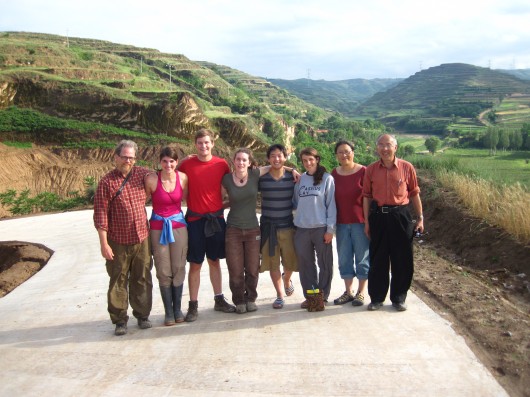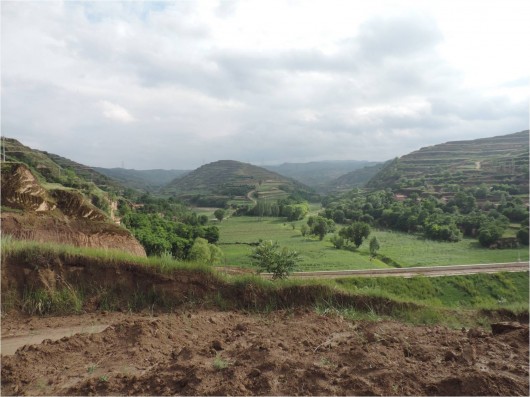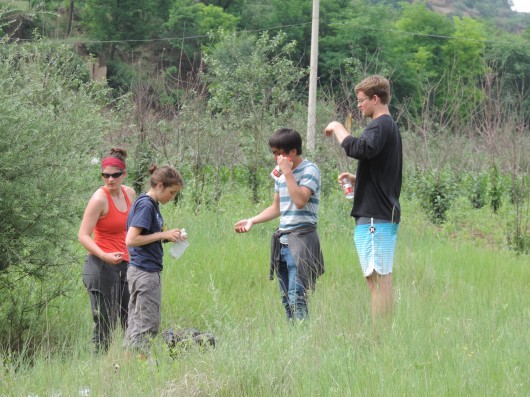Ten days ago, a group of five Americans fell asleep on United flight 835 from Chicago to Shanghai, and woke up in a drastically different place. It was hot (99 degrees), it was built up (so many skyscrapers), and it was full of people (23 million). But we’ve discovered that what lies beneath this stereotypical veneer of big-city China can be really magical.

Part of the team scoping out the field site.
Our trip to China was part of a new collaboration between St. Olaf College and Lanzhou University. The partnership is a couple years in the making, and it’s focused on fostering a mutual understanding of environmental issues, ecologically and economically, in the two countries. As the second group of Olaf students to travel to China, we were charged with furthering this partnership and doing some initial research in the Loess Plateau area.
Our study site was the Zhifang Gully in the city of Pingliang. It’s located in the Gansu Province of Northwest China, and with a population of about 500,000, it’s a small town by Chinese standards. The environment here was like nothing we’ve ever seen before. Picture huge terraced hills with swatches of golden wheat and green cornstalks, speckled with the occasional flock of sheep. The terraces were built to enable farming in an area prone to intensive soil erosion. Efforts were made over the past few years to mitigate the effects of this erosion, including re-vegetation of hill slopes, but the chocolate brown, sediment-rich streams suggest that it’s still a problem.

Terraced hillslopes in the Pingliang countryside.
Enter us, five students and two faculty members from St. Olaf College and numerous members of Lanzhou University’s hydrology department. The St. Olaf Polaris group (sans Seth) is joined by two economics students, Rob Tunheim and Kevin Klynstra, and their faculty advisor, Xun Pomponio. We were hoping to work at the intersection of economics and ecology to demonstrate the biological implications of environmental policies in the Zhifang Gully region, and to complement the work already being done by our Chinese colleagues.
We decided to focus on two main questions: nutrient transport along the gully’s stream and the role of retention ponds in ecosystem nutrient cycling. We collected gas and water samples at several points along the stream, and we had a great time sampling with the Chinese undergrads.

Teaching the economists some stream sampling techniques.
Conducting science in a cross-cultural context was an adventure to say the least. Bridging the language gap was frustrating at its worst but rewarding and unexpectedly humorous at its best. We were lucky to have Xun as a translator, but clarifying points and getting questions answered could be a long process. Thankfully, John has learned how to say Nitrogen, Carbon, and Methane in Chinese, so we’re doing okay.
Science aside, the trip proved a remarkable cultural experience. We were treated to enormous feasts three times a day by our incredibly generous hosts, and we’re coming back to Minnesota full of noodles, dumplings, hot pot, baozi, and so many stir-fried vegetables. It’s not P.F. Changs—it’s better. In addition to providing us with copious amounts of food, our hosts were quick to jump at every chance to help us, and we became fast friends.
Getting to places—by plane, train, or van—also provided an exciting window into Chinese culture. We experienced the crowded Shanghai subway, the organized chaos of congested Chinese roadways, and the surprisingly comfortable sleeper cars of countryside trains, which we were able to enjoy only after sprinting through the streets and narrowly catching our train. With sampling in the books, we also were able to pass a morning on the beautiful Kong Tong Mountain. It’s known throughout China as the birthplace of Daoism, and multiple Daoist and Buddhist temples stand regally in the hazy hills.
The work we did, the things we saw, and the experiences we had, both scientifically and culturally, underscore the importance of China’s environmental decisions and policies both locally and globally. They also gave us insight into science in a global context. Science doesn’t occur in a vacuum, we learned, but is embedded within a larger socio-cultural framework. The experiences we had in China made us better scientists, gave us a new perspective on global environmental problems, and showed us a remarkably vibrant and dynamic culture. And those lessons aren’t easily lost, even when we open our eyes and wake up to the same familiar Minnesota tomorrow.

The view at the top of Kong Tong Mountain on an uncharacteristically clear day.




Comment(1)-
Manuel says
January 24, 2014 at 12:03 amHey there,
is an excursion like this happening again? Also open to non-US University Students keen to get involved in agroecology?
Best Wishes,
Manuel